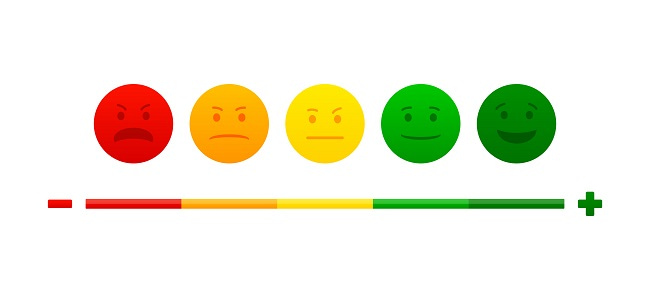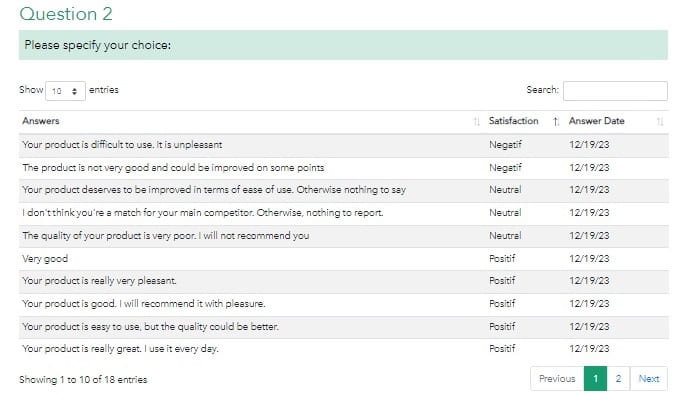The Net Promoter Score (NPS) is a highly effective tool for measuring customer satisfaction. It is based on one simple question: “Would you recommend our brand to your friends and family?” The responses obtained allow us to evaluate the brand’s reputation, customer loyalty, and the effectiveness of the marketing team’s efforts to satisfy customers. The NPS provides reliable indicators for your company’s growth prospects. How and why should you measure it? We’ll explain.
>> Create a customer satisfaction survey on Drag’n Survey, click here

How to calculate the Net Promoter Score?
The Net Promoter Score is one of the common indicators in measuring customer satisfaction. It particularly highlights customer loyalty and identifies potential brand ambassadors. The achieved score is easy to interpret. It serves as a basis for evaluating the impact of loyalty and communication campaigns that have been implemented. The NPS also allows for comparison with competing companies within the same industry.
The answer to the question “Would you recommend our brand to your friends and family” is measured on a scale ranging from 0 (not at all likely) to 10 (extremely likely).
NPS Calculation
This customer satisfaction indicator categorizes buyers into three groups:
- Promoters = respondents giving a score of 9 or 10
- Passives = respondents giving a score of 7 or 8
- Detractors = respondents giving a score of 0 to 6
The formula to calculate the Net Promoter Score is as follows:
- NPS = Percentage of promoters (scores 9 and 10) – Percentage of detractors (scores 0 to 6)
For example, if the percentage of detractors is 37% and the percentage of promoters is 57%, your NPS would be 20 (57-37).
An Absolute Number Indicator
The Net Promoter Score is not expressed as a percentage, but as an absolute number (without decimals), ranging between -100 and +100.
While the score itself counts, it’s especially its use over time and its evolution that are significant. A large increase over a few months will demonstrate that buyer satisfaction is strongly rising. It’s also important to utilize this indicator as a comparison tool between products of the same brand and with its competitors.

The Net Promoter Score, a Clear and Concrete Indicator
Used by many companies, it has the advantage of being readable and explicit for all employees and managers. It allows for the effective visualization of the results of a campaign or measures taken for buyer satisfaction.
This also makes it an excellent tool for motivating teams, who can thus see the effects of their work in concrete terms. However, it is important to use the correct framework for interpretation. Indeed, the interpretation of the results must take into account the nature of the surveyed brand, the type of products, the culture, and the countries from which the responses come.
Therefore, it is difficult to define standards in this matter. However, it can be estimated that:
- A score above 50 is considered very good.
- A score above 0 is considered good. Even if you have detractors, you can rely on a base of satisfied and loyal buyers.
Beyond the score, the real value of the Net Promoter Score lies in the responses and comments provided by respondents. This is where the explanation for the given score can be found. Therefore, the survey should include questions such as: “How can we improve our service?” for someone who gave a score between 0 to 6, or “What do you particularly like about our brand?” for promoters.
Regarding comments on satisfaction, the online survey software Drag’n Survey has developed artificial intelligence that scans the comment and determines if it is neutral, negative, or positive. A word cloud is also generated to see the positive and negative trends that emerge.


When should you conduct an NPS survey?
There are three different types of surveys for measuring customer satisfaction. Surveys can be conducted immediately (hot), soon after (lukewarm), or well after (cold) the interaction.
“Immediate” Surveys
These are administered directly following an interaction with the brand such as a purchase, a call, a shop visit, delivery, etc. They can be carried out a few minutes to a few hours after the purchasing experience. This method provides an excellent response rate.
“Lukewarm” Surveys
These are customer satisfaction surveys conducted a few days after the interaction. While they are less frequent than immediate surveys, they offer more measured responses, given after a period of reflection. This helps avoid emotionally charged ratings that could be excessively positive or negative. It also allows time to use a product and evaluate, after several days, whether it meets consumer expectations.
“Cold” Surveys
These are conducted outside of direct interactions and serve to verify that the customer is satisfied with the product or service. It’s recommended that this type of survey is conducted once a year, with the customer base divided into different groups. This allows for a consistent survey cycle throughout the year. Typically, this type of satisfaction survey gets a 10 to 20% response rate.
For the Net Promoter Score, cold surveys are considered ideal. They are the most suitable for measuring a company’s true brand image, free from excessive emotions such as enthusiasm or dissatisfaction due to an incident during the purchasing experience.
Measuring the Net Promoter Score allows you to get closer to your target audience and provides an endless source of information and ideas to better understand the needs and expectations of your purchasers.
More about surveys:
User-Friendly Online Survey Tools That Rival SurveyMonkey, click here
Explore the Top 5 Surveys and Form Tools Beyond Typeform, click here
Crafting Effective Options: Developing Multiple Choice Questions, click here
Upgrade Your Form Experience with 5 Superior Alternatives to Google Forms, click here
Elevate Your Customer Feedback with These 14 Key Satisfaction Survey Questions, click here
Read the article:
German – Was ist der Net Promoter Score (NPS)? click here
French – Qu’est-ce que le Net Promoter Score (NPS) ? click here
Portuguese – O que é a pontuação de promotor líquido (NPS)? click here
